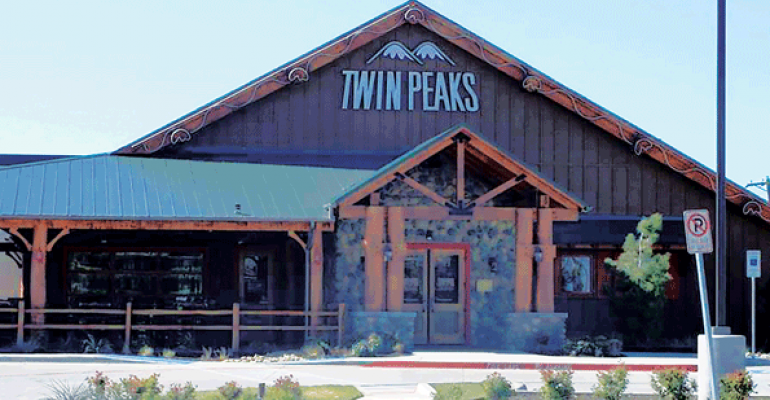Casual-dining sales have struggled this year, but Twin Peaks has been a segment leader in keeping sales and traffic positive.
 Joe Hummel succeeded Starlette Johnson as CEO of Dallas-based Twin Peaks after franchise group La Cima Restaurants LLC agreed to acquire a majority interest in the company. Twin Peaks has been leading other casual-dining brands in both the Knapp-Track and Black Box Intelligence surveys.
Joe Hummel succeeded Starlette Johnson as CEO of Dallas-based Twin Peaks after franchise group La Cima Restaurants LLC agreed to acquire a majority interest in the company. Twin Peaks has been leading other casual-dining brands in both the Knapp-Track and Black Box Intelligence surveys.
Hummel said Twin Peaks’ new leadership is looking to tap into the energy of the founding of the male-oriented sports bar chain in 2005.
“We’ve been taking the brand back to what the original philosophy was, trying to make sure our direction was narrow and deep,” Hummel told Nation’s Restaurant News. “We’re obviously a demographic heavily skewed toward a male audience. We wanted to make sure we redirected our efforts into the lodge that we had originally.”
Hummel said the company is looking to fill franchise white space for the 80-unit chain.
“Right now we have 35 franchised stores and 45 company stores,” he said. “So we’re going to work on filling in the Mid-Atlantic and Northeast, as well as some of the Midwest area and the Ohio market. We’ll be looking to do franchise development in the West in the next six to 18 months with new partners.”
In a wide-ranging conversation, Hummel outlined his vision for Twin Peaks:
How do you approach operations?
We’re staying localized. We thought it was important to be a local brand. We wanted every restaurant to have that. I’m now in Jackson, Miss., and I want this restaurant to be the Jackson, Miss., lodge. We went after the craft beer market with local beers.
What about the sports bar atmosphere?
We made sure we were heavily invested in our TV-audio-visual packages. We want to make sure we are the place for sports, no matter whether it’s NFL, March Madness, NBA, NHL, MLS. We want to make sure the local market knows this is where they can come for any game they want to catch.
How has that approach changed from your days at Hooters?
We lay out the buildings so no matter where you are sitting in the restaurant, you can see from three to five TVs. That’s a really big component of what makes our sports package attractive. We try not to miss out on any sporting events. And a 50-inch TV used to be a big deal; now everyone has one at home. Ours are over the top. The largest we have is a 110-inch, but on average its 70s and 80s.
And the staffing?
We made sure our Twin Peaks girl is at the forefront. She’s a big part of our brand DNA. She gives us an extra edge that others don’t have.
What is Twin Peaks’ advantage in this market?
We sell an experience when you come to Twin Peaks. That experience can be a whiskey experience, a draft beer experience, a scratch kitchen experience, a sporting event or sitting around a fireplace.
What are the bestsellers on your menu?
Our burgers have a really good following, between the Billionaire Burger and the Hangover Burger. From a shareable, our wings are strong in the product mix, especially being in the sports environment. We revamped our wing program last August. Double-Stacked Nachos are really strong.
How are you keeping same-store sales positive?
We’ve concentrated heavily on the four walls. We make sure we are properly staffed. We make sure we have managers on the floor, touching the tables. Our girls’ hospitality is second to none. And we focus on a one- and three-mile radius around our building and how we draw guests in.
What approach do you take with pricing?
We take a barbell approach on the menu, whether it’s the food or the beverage side. We want to make sure we can offer a really good value, or offer you something high end where you can spoil yourself.
What are the biggest challenges ahead?
Obviously, casual dining has some challenges. There are a lot of seats out there. Casual dining is competitive. We have to make sure we are executing our DNA. Our challenge is to make sure we are executing at the highest level. We look at everyone who serves food and beverage as a competitor. When you are deciding where to eat, we want you to think of us.
Are you planning more international development beyond your restaurant in Russia?
They’ve done a nice job. They are looking at something in Moscow. We’ll obviously look at the Asian markets — Singapore, China — and Europe, Canada and Mexico. At Hooters, we were in about 25 countries when we left in 2011. We’re familiar with how to expand a brand internationally.
Contact Ron Ruggless at [email protected]
Follow him on Twitter: @RonRuggless




